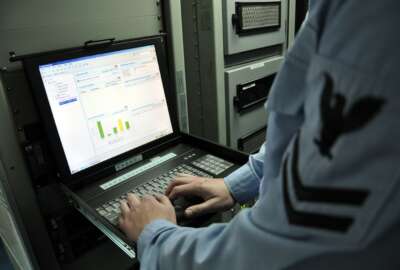

The Navy is preparing two major plans to make data management better.
In the next few months the Navy will unleash a handful of new policies it hopes will transform the way it handles data so that information can be harnessed for technologies like artificial intelligence, analytics and other forward-facing technologies.
The policies follow a trend of revolutionizing data management found in the Defense Department and other military services as they recognize the current way they label, sort, store and organize data is making the military vulnerable, keeping it from making better informed decisions and missing out on advanced technologies.
“The idea here is we are going to start using our data to make decisions, and then we are using our data to prove the decisions we made were sound,” said Thomas Sasala, Navy chief data officer, on Monday at the AFCEA NOVA Naval IT Day in Tysons Corner, Virginia.
The shift in thinking about data starts outside of the Navy and comes from DoD as a whole. The Pentagon will release a data policy in the next month. That policy, which is a creation of the data chiefs in all the services, will outline the military’s strategy for data; how it will be standardized, created and worked on.
Navy Chief Information Officer Aaron Weis said there is no sense in the Navy reinventing the wheel and creating another data policy of its own.
Instead, the Navy will create an implementation plan in the next three months based on that overarching data policy and release a concept of operations plan for how the overarching ideas of the DoD plan will work for the Navy.
On the concepts side, the Department of the Navy will have two deputy chief data officers — one for the Marine Corps and one for the Navy. It will also create a data governance board, which will report directly to the undersecretary of the Navy.
“The concepts plan’s data management center is really based around data stores,” Sasala said. “Not around offices, not around resources, not around organizations that claim they want to own specific systems. It’s based around the information itself. We will have a data store for financial data, we will have a data store for medical data, we’ll have a data store for logistics data.”
Each of the stores will have their own functional domain managers to break the domain up. For example, financial management may have one for budgeting and one for planning. Those managers will be responsible for how the Navy represents its data in those areas and be the gatekeepers of that information.
“Hopefully these managers will meet monthly and will make decisions about the standards and equities,” Sasala said.
The plan will put concrete measures in place to make data more workable and usable. It will focus on five lines of effort:
Leaders will be assigned to the lines of effort as well. The CDO will most likely be in charge of setting the foundation and governing.
“That implementation plan is going to be a living document,” Sasala told Federal News Network. “It’s going to be our road map for where we’re going. As we finish things they will come off the list. As we need to do new things they will go onto the list and as the environment changes we need to continuously modernize.”
The plan will be revisited every six months.
Sasala said he thinks the Navy can move quickly and grab low-hanging fruit like predicative maintenance. The services will also work on mid- and long-range goals.
Currently, there are no funds or resources obligated to the plan, but Sasala is optimistic that the plans can still make changes within the services.
The Navy will start cleaning its data and organizing things for technologies like AI with new programs first. From there it will move to its legacy systems.
“The Navy has a number of platforms coming online very quickly that are going to be groundbreaking in how we manage our systems and by extension we have the opportunity to use those to be groundbreaking in terms of data management,” Sasala said.
Those systems will replace some legacy systems and finally let those systems go.
Copyright © 2025 Federal News Network. All rights reserved. This website is not intended for users located within the European Economic Area.
Scott Maucione is a defense reporter for Federal News Network and reports on human capital, workforce and the Defense Department at-large.
Follow @smaucioneWFED

